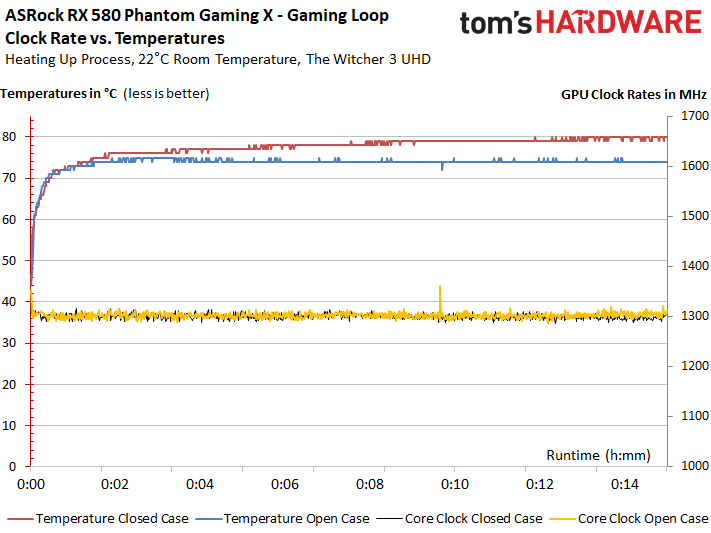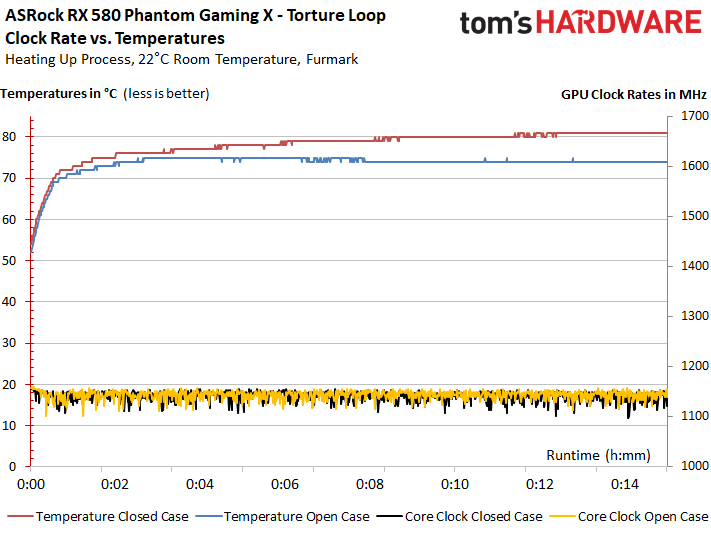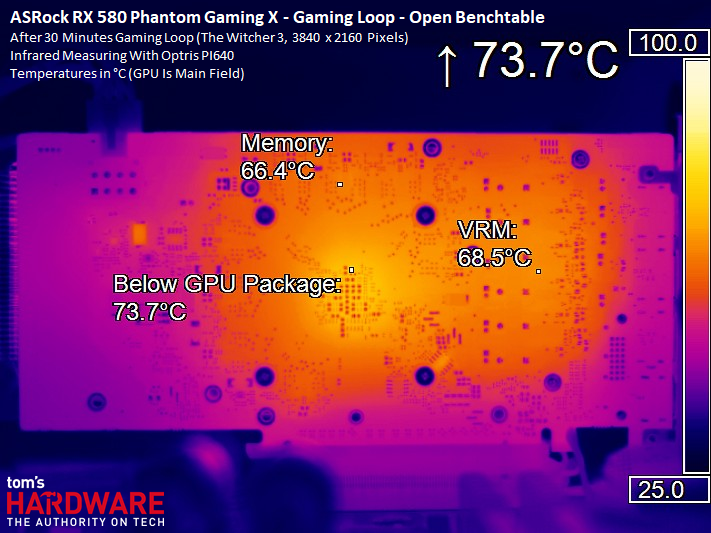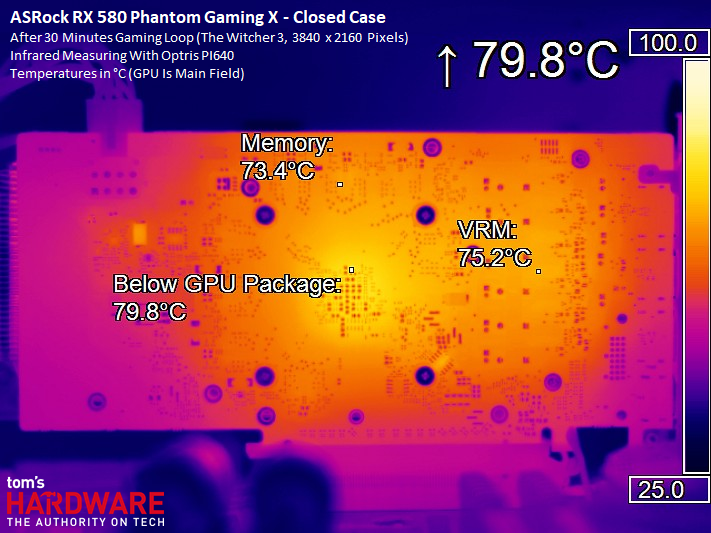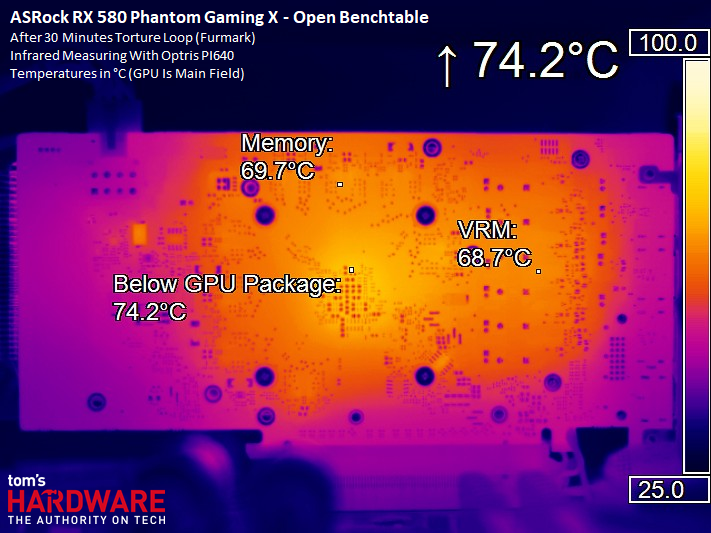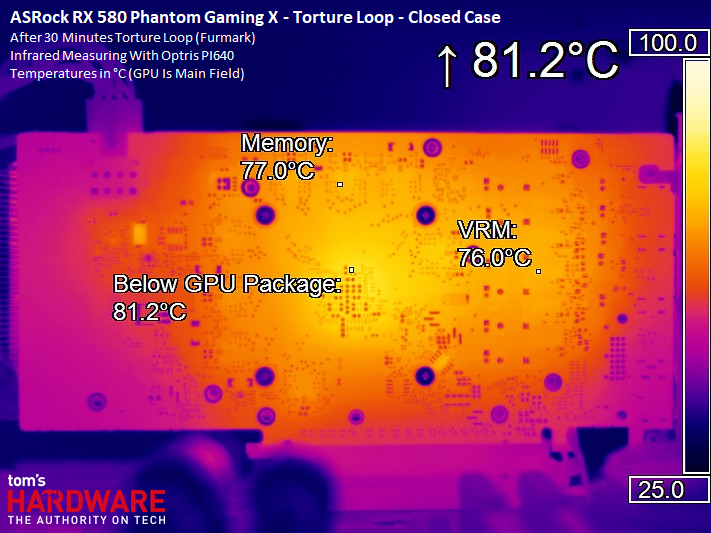ASRock Phantom Gaming X Radeon RX580 8G OC Review: A Solid Rookie Effort
Why you can trust Tom's Hardware
Temperatures & Thermal Image Analysis
The conventional approach to overclocking by means of a higher power limit and clock rate ceiling doesn't make sense in this case. ASRock's thermal solution is already operating at its limit, and consequently fairly loud. On the other hand, undervolting AMD's Ellesmere GPU yields impressive results. Don't expect more performance. Rather, count on lower power consumption, a slower-spinning fan, and a little less noise. We didn't spend much time experimenting with this on ASRock's card, though, since real-world gains vary from chip to chip.
The following table shows a comparison of start and end values for temperatures and GPU (boost) frequencies. Just keep in mind that these clock rates can be considerably higher in games with significantly lower loads.
| Header Cell - Column 0 | Initial Value | Final Value |
|---|---|---|
| Open Test Bench | ||
| GPU Temperature | 44°C | 74°C |
| GPU Clock Rate | 1380 MHz | 1307 MHz |
| Ambient Temperature | 22°C | 22°C |
| Closed Case | ||
| GPU Temperature | 45°C | 80°C |
| GPU Clock Rate | 1380 MHz | 1296 MHz |
| Air Temperature in Case | 25°C | 40°C |
Temperature vs. Frequency
To better illustrate our findings, we plotted temperatures and frequencies during our sample's 15-minute warm-up phase. It's particularly interesting to note the difference in temperature between the open test bench and closed case. Yet, their clock rates remain surprisingly similar.
Our stress test's chart doesn't look much different: the open bench and closed case still diverge quite a bit. You do, however, see much lower clock rates.
IR Image Analysis Of The Board's Back
To round out this section, we take a look at board temperatures across several different load levels. Because ASRock doesn't bother with a backplate, we don't have to fiddle with drilling holes or disassembling the cooler.
Gaming
Hot-spots aren't an issue for this card in The Witcher 3. We measure almost 74°C opposite the GPU package on an open bench, and almost 69°C behind the voltage regulation circuitry. As mentioned earlier, spreading those components out across multiple discrete pieces makes cooling easier.
In a closed-up case, temperatures behind the voltage transformers rise by about 6°C. Same goes for the GPU package, which is now close to 80°C.
Get Tom's Hardware's best news and in-depth reviews, straight to your inbox.
Those higher temperatures are accompanied by faster-spinning fans. ASRock's temperature limit is set rather tightly, so more airflow is the only way to ensure that threshold isn't exceeded.
Stress Test
An extended run of FurMark reveals slightly higher power consumption than our gaming workload, though you wouldn't really know it from our thermal readings on an open bench. At the end of the day, faster-spinning fans help mask the difference.
Seal ASRock's Phantom Gaming X up in a chassis, though, and the temperatures are now up roughly 7°C, even with the fans spinning faster.
ASRock's cooler performs the way it should. However, there is no headroom left for overclocking or dialing back the fan speed to reduce noise.
Heating and Cooling
The last two pictures show where heat builds up as the card is used, and where it starts cooling off first when the load is removed.
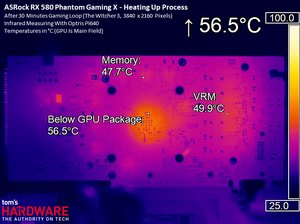
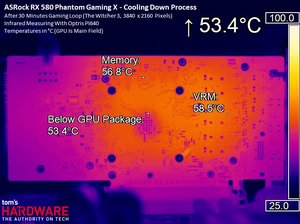
MORE: Best Graphics Cards
MORE: Desktop GPU Performance Hierarchy Table
MORE: All Graphics Content
Current page: Temperatures & Thermal Image Analysis
Prev Page Power Consumption Next Page Cooling & Noise
Igor Wallossek wrote a wide variety of hardware articles for Tom's Hardware, with a strong focus on technical analysis and in-depth reviews. His contributions have spanned a broad spectrum of PC components, including GPUs, CPUs, workstations, and PC builds. His insightful articles provide readers with detailed knowledge to make informed decisions in the ever-evolving tech landscape
-
Ulikedat At least it's a looker and the competition just got a bit more heated (no pun intended).Reply -
alextheblue I have to wonder, since aiming for a cut-down budget design, why not an RX570? An entry level RX580 with halfway decent cooling can be had new for $270. The cheapest 570 I've seen is a reference model for $250. Push a budget aftermarket RX570 closer to $200 and undercut everyone else. Clocks and TDP would be lower (especially if they stuck close to reference), which would have further reduced board and cooler costs.Reply
Or perhaps yields are so good at this point, that there just aren't many cut-down Ellesmere chips getting pushed out the door? -
BulkZerker @alextheblue they are pushing the bang for buck at every point it seems. It begs to wonder if some "cheap" (like as5) thermal paste would help or not. Certainly an aftermarket heatsink would help the temps.Reply -
TJ Hooker If this card is like most 580s, it will respond quite well to lowering the core voltage. With some undervolting (and maybe a slight underclock), you could likely improve power, thermals and noise noticeably with no (or little) impact on performance.Reply -
AnimeMania What's going on with the numbers for GTX 1060 3GB with certain games like Hitman and DOOM, they can't really be that bad, can they?Reply -
Sleepy_Hollowed This is quite a nice card, especially for those looking to switch to FreeSync and the open drivers that AMD provides (For accelerating stuff like data compression or video encoding).Reply
Like all cards, I just wish it was available, this crypto craziness is on the downslope for now, but you never know when cards are just going to be missing from the shelves for months. -
Olle P Reply
Around here there's almost no price difference between a 570 (4GB) and 580 (8GB). The latter is significantly better at the all important 1080p so that's where to make profit.21064926 said:I have to wonder, since aiming for a cut-down budget design, why not an RX570? ...
One can only hope. The 180W drawn is a bit steep IMO.21065443 said:If this card is like most 580s, it will respond quite well to lowering the core voltage. ...
Seems off topic...21065545 said:What's going on with the numbers for GTX 1060 3GB with certain games like Hitman and DOOM, they can't really be that bad, can they?
The 3GB is a cut down version of the 6GB, with fewer ROPs and less memory bandwidth. 3GB VRAM is also insufficient to run newer games efficiently. -
AnimeMania Reply
According to another review on Tom's Hardware, the GTX 1060 3GB had 68.1 FPS on Hitman at Ultra Levels.21066401 said:
Seems off topic...21065545 said:What's going on with the numbers for GTX 1060 3GB with certain games like Hitman and DOOM, they can't really be that bad, can they?
The 3GB is a cut down version of the 6GB, with fewer ROPs and less memory bandwidth. 3GB VRAM is also insufficient to run newer games efficiently.
https://www.tomshardware.com/reviews/nvidia-geforce-gtx-1060-graphics-card-roundup,4724-2.html
The GTX 1060 3GB in this article had 21.2 FPS on Hitman at Very High Levels. I don't think it is off topic if I am questioning the reliability of the benchmarking process used here. I was just wondering why the results seem to fluctuate so wildly. One value is 3 times higher than the other. -
alextheblue Reply
That was my point. There's less competition for cheap RX 570s. Their 580 design cuts down on costs across the board (pun intended). They could cut down even further with the lower-TDP (and presumably cheaper) RX 570 and undercut the entire field substantially. An RX 570 at ~$200 would be enticing for budget builds.21066401 said:Around here there's almost no price difference between a 570 (4GB) and 580 (8GB). The latter is significantly better at the all important 1080p so that's where to make profit.
When they first came out there was often a substantial price difference between full Ellesmere and cut-down Ellesmere. That's why I'm speculating that there just isn't enough supply of 570 chips to make this possible.
